Subscribe Our Newsletter
Get the latest news, offers and inspiring travel stories straight to your inbox.
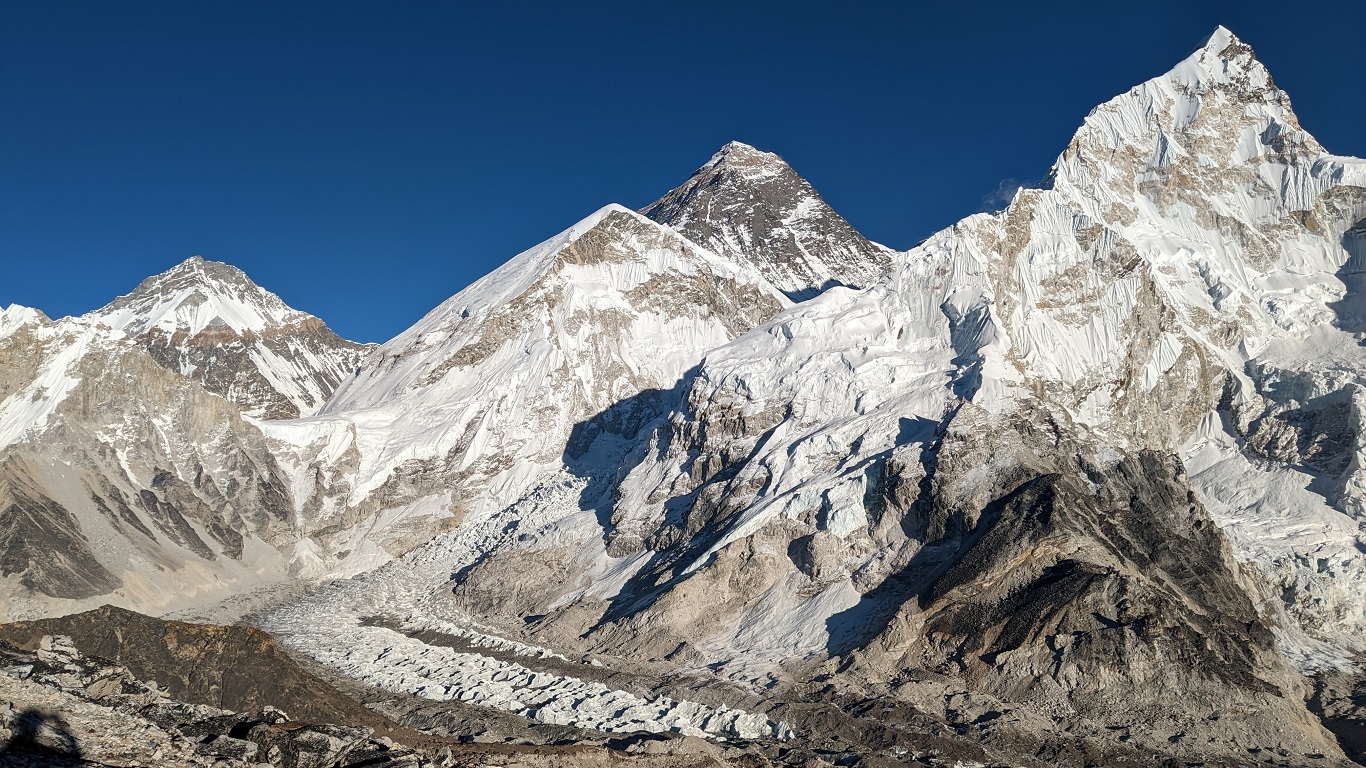
The Team Himalaya Special Everest Base Camp trek is an incredible adventure in the heart of the Everest Region. Filled with a magnificent natural environment and a close view of the world's highest mountain, Mount Everest, it is a dream destination for many trekkers. This trek is not just for mountain lovers- it is for those who want to enjoy and get lost in the natural beauty.
On this Special Everest Base Camp Trek you can see amazing sights like Mt. Khumbila (5717m), Mt. Taboche (6495 m), Mt. Nuptse Peak (7861 m), Mt. Everest (8848 m), Mt. Lhotse (8516 m), Mt. Ama Dablam (6856 m), Mt. Thamserku(6623 m), and many more.
Everest Base Camp Trek is also known as teahouse/lodge-lodge trekking in the mountain region. You will spend the night in the tea house which is run by the family of local people living in that region. Immersing in Sherpa culture, trekking to picturesque villages, and experiencing warm hospitality—these moments stay with you forever.
You will trek with the local friendly Sherpas Guide known for their mountaineering expertise. They will not only help you navigate the trail path and help in an emergency evacuation but also listening to their stories and traditional songs adds charm to the journey.
Your Team Himalaya Special Everest Base Camp Trek begins when you arrive at Lukla Airport. With the assistance of your guide and porter, you'll follow the Dudh Koshi River, passing through the Sagarmatha National Park on your way to Namche Bazaar. The day-to-day journey to Base Camp is an incredible and fulfilling experience.
The trail takes you to higher altitudes, first reaching Namche Bazaar and then progressing through Tengboche, Dingboche, Loboche, Gorak Shep, and finally, the Everest Base Camp at an elevation of 5,364 m. The ultimate challenge, both in terms of altitude and personal endurance, is the ascent to the thin-air summit of Kala Patthar at 5,545m.
The Everest trek is not only a physical journey but a spiritual journey as well. Visiting many Buddhist monasteries and chortens and watching monks praying gives you a completely different taste.
Experience the Special Everest Base Camp Trek offered by the Team Himalaya. Unlike the regular Everest Base Camp Trek, we provide a special package for our clients. Unique adventure and providing an extraordinary experience service is our main goal. Begin your journey with us.
Welcome to Nepal and yours! When you land at the airport in Kathmandu, one of our friendly Team Himalaya representatives will be waiting to meet you at the airport terminal. We'll welcome you to Nepal and then take you to your hotel in the lively Thamel area of Kathmandu. You'll be staying in a comfortable 5-star hotel for the night.
Soon after you get settled in at the hotel, you'll have a trek briefing with your knowledgeable Team Himalaya trek guide. They'll provide you with all the details you need to know for your upcoming and answer any questions you have.
The rest of the day is free for you to explore fascinating Kathmandu on your own before getting a good night's sleep to be ready for the start of your Himalayan adventure!
You will have breakfast in the hotel early in the morning before leaving for the airport. Your guide from Kathmandu will travel with you to the Lukla airport and introduce you to the porters after the landing. The trek includes full board meals.
You will get breathtaking views of the Eastern Himalayas during the trip, provided the weather is favorable. The stunning view of the mountains from the plane will captivate you. As you take in the splendor of the Himalayas, the 35-minute trip will seem like only a few minutes.
Soon after, you can gradually stroll past Lukla's marketplaces and shops before heading downwards for a bit, with brief ascents and progressively meandering paths that pass through settlements.
From Lukla to Phakding, you will continue your journey over astonishing landscapes. You will cross suspension bridges and go through the Dudh Kosi Valley's breathtaking scenery.
This day starts with trekking deeper into the Khumbu region. The walk passes through Tok-Tok, Bhenkar, and Monjo before crossing many suspension bridges over the Dudh Kosi River and landing at the Sagarmatha National Park entrance gate, where a permit must be purchased.
The view of Thermasharhu Peak and the Khumbi-la Mountains is quite breathtaking. The principal entrance to Sagarmatha National Park is near Monjo. After getting the necessary permits and making the necessary payments, you may pause at the park gate before moving on to Jorsale Village for lunch.
If luck is on your side and the weather is clear, you might be able to view Everest and the Lhotse in addition to the magnificent Himalayas (Kwangde and Kusum Kanguru). When you arrive in Namche, you may witness highland Sherpas, lowland porters, and Tibetans trading food and supplies in the marketplace.
Having consistent acclimatization days is essential for a successful trip to the base of Everest. Along with acclimatization, this day should be spent touring the markets and taking in the views. There are many places to explore in and around Namche. You'll explore Namche even on days when you're becoming acclimated.
The primary hub of the Everest (Khumbu) area is Namche Bazaar, which features a vibrant market every Friday and Saturday night along with government offices, ATMs, internet cafés, stores, restaurants, and a bakery.
The museum in Namche is another place you should go while getting used to the altitude. It has a wealth of knowledge about the Khumbu region. The Everest View Hotel, which is regarded as the highest hotel in the world, is open for you to stroll inside.
From there, Everest, Lhotse, Twache, Tarmasarku, Kwangda, and AmaAblam are all visible up close. Thus, you can get the right amount of acclimatization with a little hike of only a hundred meters. You could converse with other hikers as evening descends if you notice them perusing the stores.
It is an acclimatization trek through the Syangboche airstrip. There is a tough ascent out of Namche. The trek is about an hour and a half and brings everyone into the Khumjung Village - a typical Sherpa village in the Khumjung Valley.
In addition, visitors may view the Khumjung and Khunde monasteries, the Khunde hospital, the Hilary school, the Yak breeding facility, etc. Also, you can see the Edmund Hillary-built school was spared significant damage from the Khumjung earthquake.
The trip continues along the Dudh Kosi's swiftly moving glacial waters, offering breathtaking views of the surrounding mountains, including Mt. Everest, Lhotse, Taboche Peak, and Amadablam.
You come across a broad expanse of alpine woods and an ImjaTse river as you descend to Phungi-tenga for lunch. When you get to Tengboche for the night, you will have to climb through gorgeous pine and rhododendron-studded forests for a few hours, all while enjoying the breathtaking vista of the surrounding peaks.
The location also provides a breathtaking view of several peaks, but as afternoon approaches, lamas and monks start chanting prayers in the adjacent gumba, attracting everyone's attention.
The Tengboche region has a few teahouses, lodges, and a bakery next to the monastery. Visiting Tengboche monastery is an important highlight for many trekkers in the Everest region of Nepal.
Tengboche Monastery is a very important Buddhist monastery located in the Himalayas of Nepal. It is the oldest and the largest monastery in the Khumbu region having been built in 1916.
The monastery has a very peaceful and serene atmosphere. The main temple houses a huge statue of Sakyamuni Buddha. The monks at the monastery perform various rituals and prayers each day. Tengboche is also known for its Mani Rimdu festival which happens in autumn when people come from far and wide to witness the masks and dances.
After an incredible night at Tengboche, the following morning will see you making your way back down through a lovely forest and across the ImjaTse River on a bridge. You have to climb for a bit before descending to reach Pangboche village, which is the final permanent community along the EBC route.
You will climb back up to the Shomare settlement for lunch once again. It is a brief trek of four or five hours from Tengboche to Dingboche, which you will probably do in the afternoon. It's difficult to climb the last slope into Dingboche at this high altitude.
Later, the path separates, with the left track climbing up to Pheriche before crossing a suspension bridge.
By spending two nights in Dingboche, you allow your body to recuperate and renew itself at a consistent sleeping height, which aids in your acclimation to the constantly rising altitude. On this day, you'll be able to enjoy Dingboche's natural beauty in addition to obtaining some relaxation.
From here, you may climb a short distance to a viewpoint that offers views of the expansive ImjaTse valley, also known as Nagarjuna Hill, and the adjacent Himalayan background of Mt. Makalu, the fifth-tallest mountain in the world, to the east.
This would include a three- to four-hour trek to Nangkartshang Peak, which is situated just above Dingboche and offers breathtaking views of the surrounding mountains, particularly Ama Dablam.
With breakfast, you will begin your journey with a stroll in the direction of Thukla and then traverse the steep Khumbu Glacier terminal moraine. It takes around six hours to trek from Dingboche to Lobuche.
You'll be led to a little lunch eatery in Thukla as you proceed. This is the intersection of the Gokyo via the Tshola and Pheriche path, and the Khumbu glacier melting into the neighboring river is seen.
Once you refuel with some delectable local fare, you have an hour's hike to the cairn at the top of Thulga Pass. You're in for a fantastic day filled with breathtaking Himalayan views. You will stay overnight in Lobuche.
Your six to seven-hour journey to the base camp of Mount Everest begins after a hearty breakfast. You will pass the glass pyramid observatories that Italian and Nepalese scientists have been investigating on the nearby glaciers throughout your several-hour journey. The memorials to the Indian army mountaineers are situated along the path.
You'll pass stony dunes, moraine, and streams before reaching the Mt. Everest Base Camp. You will reach the Gorakshep where you can store your luggage before heading to Everest Base Camp.
As soon as you reach Everest Base Camp, you will get amazing close-up views of the Khumbu icefall and glaciers. Take in the breathtaking views of Nuptse, Lho-la, Changtse, and the Great Everest. We will also be able to see climbers' tents at the base camp during the climbing season.
After exploring Everest Base Camp, we will return to our teahouse at Gorak Shep for an overnight stay. The roundtrip trek between Gorak Shep and Everest Base Camp offers some of the most dramatic scenery of the entire journey.
You start your trip at four in the morning in the bitter cold (-10 to -14 C). At this height, chilly winds are not uncommon. At 5545 meters, Kalapathar is the highest point on this tour and provides an amazing view of Mount Pumori, Kalapathar's craggy peaks, and Everest.
You will return to Gorakshep for breakfast after soaking in the expansive vistas and frantically capturing pictures and then descend through Lobuche and Thukla to the newly created Pheriche trail. From Pheriche, you will trek downwards to the towns of Somare and Pangboche.
Today, the route meanders through verdant woodlands with vivid rhododendron blooms, providing a lovely setting. The sound of the roaring Dudh Koshi River follows you on your descent, providing a calming melody to your travels. You'll feel a surge of adrenaline as you negotiate the difficult river crossings on sturdy suspension bridges.
Your route descends quickly through pine trees and into the Dudh Koshi Gorge before arriving at Sansa. The Dudh Koshi River is known as the "milky river" in Nepali. You'll feel a surge of adrenaline as you negotiate the difficult river crossings on sturdy suspension bridges.
With every step, one feels more excited to enter Namche Bazaar, a bustling Sherpa community full of activity. When you finally arrive, you'll be greeted with the kind hospitality of the locals, enthralled by the bustling markets, and in awe of the stunning scenery of the surrounding mountains.
Once you have had one final chance to peruse the bazaars, you bid farewell to the lofty mountains and return to Monjo and lunch in the warmth of the Dudh Khosi. It takes around five hours to trek from Namche Bazaar to Phakding.
Therefore, you also get to see magnificent vistas and capture wonderful images of the place. When you get to Phakding, you will stay at a lodge for rest.
This is the last day of your journey before you head back to Lukla, where you started. The Dudh Koshi River roars by as you descend, weaving through thick forests and suspension bridges. As you approach Lukla, the sight of prayer flags greets you and signifies the end of your incredible journey.
This is the moment to think back on the treasured memories of your group journey and your accomplishment of your objectives. Having a free afternoon gives you the chance to unwind and take a nice shower.
You'll celebrate with a few beers and dance in the evening. Here's where you bid your trekking group farewell.
After your 14-day trip, you catch an early morning flight from Lukla to Kathmandu. Get ready for a wonderful ride that affords sweeping vistas of the breathtaking Himalayan peaks. You'll be treated to an amazing overhead view of the untamed landscape you hiked through as the little plane takes off.
After arriving in Kathmandu, you might take a rest or do some shopping. After you arrive at your hotel, you take some time to relax and reflect on the incredible experience you have just completed.
The vibrant and intriguing city of Kathmandu is full of surprises. The historic cities of Patan, Bhaktapur, and Kathmandu are all part of the Kathmandu Valley. The intricately carved wooden columns and pillars, the skillfully constructed temples and palaces, and the finely etched pictures on stone and metal.
Among the amazing sights of Kathmandu Durbar Square are the fearsome Kal Bhairav, the red monkey god, the home of the Living Goddess (Kumari Ghar), and hundreds of sensual sculptures.
Swyambhunath, the most mysterious and ancient religious complex in the world, is perched atop a hill on the western border of the Kathmandu Valley. Surrounding it are stupas, a variety of shrines, temples, painted pictures of deities, and many other religious artifacts.
One of the biggest stupas in the world and the holiest Tibetan Buddhist temple outside of Tibet, Boudhanath is located in the town of Boudha, dominating the skyline on the eastern outskirts of Kathmandu.
The most sacred Hindu pilgrimage site in Nepal is Pashupatinath. The complex has sculptures, shrines, and temples devoted to many deities, including depictions of Shiva.
Today marks the conclusion of your journey, but the memories you make will last a lifetime. You will prepare to bid farewell to a nation that provided you with such a wonderful chance to see Mount Everest.
You'll have plenty of time on the way home to organize your nearest excursion and take in Nepal's most breathtaking mountain views.
Everest Base Camp Trek lets you enjoy walking in the amazing Himalayan paths and discover mountain monasteries and the Sherpas' unique traditions. Sherpa people take care of the mountains. They not only live near them but also find joy and worship in the mountains.
The best part about Sherpa culture is its special customs, traditions, and way of life, all rooted in Tibetan Buddhism. Sherpas are famous worldwide for their climbing and trekking skills, as well as their warm hospitality. They love their traditional music and dances, celebrate vibrant festivals, and cook up delicious food. Many people are drawn to Sherpa culture and their connection to the Himalayas, especially Mt. Everest.
Sherpas celebrate lots of festivals inspired by Tibetan Buddhism. Some of the important ones include Losar, Mani Rimdu, Palden Lhamo, and Dumje.
Losar: For the Sherpa people, Losar is their main New Year's Day. On this special day, everyone comes together at Stupas and Monasteries. They chant mantras, which are like special prayers, and pass around fire torches among the crowd. People dress in their traditional clothes and make delicious feasts. There's also a cool dance that happens—it shows a battle between a deer and a King. Losar is a time for celebrations, prayers, and fun traditions for the Sherpa community.
Mani Rimdu: Buddhists have a special celebration called the Mani Rimdu festival. It's like a big party where they pray for the world to be happy and safe. Sherpas, who are people from the Himalayan region, gather to join in the celebration. They play traditional drums, sing, and chant in the mountains. The festival takes place near Mount Everest at Tengboche Monastery. For three whole days in November, the monks there wear masks and dance, and everyone prays together. It's a really important and joyful time during Nepal's festive season.
Palden Lhamo: "Palden Lhamo" means "Glorious Goddess," and it's also called the "Women's Festival" in modern Tibet. During this special time, people do many religious activities. Girls and women dress up and visit temples to pray. They offer Khadas, which are traditional scarves, to their respected angels. They also go shopping, enjoy delicious food, and do something unique—they ask men for money to donate to the fairies. It's a time of celebration and sharing for women during this festival.
Dumje: This festival takes place in Nepal exactly two months after the Buddhist New Year. It goes on for four days and during the Dumje festival lamas wearing masks perform dances, prayers, and rituals. After each festival day, local Sherpa villagers gather to have a merry time with Sherpa dancing, singing, talking, and having good drinks.
During your journey from Lukla, you will be treated to beautiful views of Mount Everest and other majestic mountains. But the most exciting part is when you reach Kala Patthar, a high spot along the trek, about 18,514 feet high. This is the place where you can see the real magic also known as vintage point.
The first light of the day slowly lights up Mount Everest and the nearby peaks. It's like a dream for every trekker. Also, the best part is you get a complete 360-degree view of the entire Everest region. This place is also known as a photographer's paradise. Not only do you watch the sunrise, you'll feel a sense of accomplishment. It's a memory that will stay with you, reminding you of the incredible beauty of the Himalayas.
Also while we acclimate at Namche Bazaar you will hike to the Everest View Hotel. It is also one of the vantage points where you can enjoy the Gorgeous vistas of Everest while having dinner in this Hotel.
On another acclimatization day at Dingboche, you will visit the Nangkartshang Peak. Nangkartshang Peak is situated at 16,677 feet. From this vantage point also you can see the entire view of Everest which is truly extraordinary.
You need Khumbu Pasang Lhamu Rural Municipality fees, Sagarmatha National Park Entry Permit for the EBC Trek, And the Gauri Shankar Conservation Area (Optional).
1. Khumbu Rural Municipality Permit
You need this permit after you arrive at Lukla. There are no alternative offices in Kathmandu that issue this permit. You can obtain this permit in Monjo. For the foreigners and SAARC nationalities, it will cost you RS 2,000. If you stay longer than four weeks, then you need to pay a fee of RS2500.
2. Sagarmatha National Park Entry Permit
You can get this permit in Kathmandu or at Monjo at the entry gate. This permit is free for children under 10 years of age.
•Foreigners: NPR 3000 per person + 13% VAT.
•Residents of SAARC: NPR 1500 per person + 13% VAT
•Nepalese: NPR 100 per person + VAT of +13%
Lukla is the hub for trekking in the mountain region. It takes around 30 minutes to reach Lukla from the TIA. Trekkers will feel nervous when they have to fly for the Lukla because it is recognized as the world's most dangerous airport. The small runway and surrounded by the high mountains and forest make it scary but safe to travel.
You'll see amazing sights from the Lukla flight like Langtang, Gaurishankar, Everest, and other big mountains. The landscapes are beautiful, and you'll pass through traditional villages, making the trek a great experience.
Due to unpredictable weather conditions, the chances of flights getting delayed/cancelation can be high. It is for the traveler's safety. The Civil Aviation of Nepal will not allow flights until they are safe. Also, during the peak seasons or bad weather conditions, the flight might be diverted to Manthali Airport in Ramechhap.
The best time or idol time to do the is during the spring (March-May) or autumn (September-November) when the weather is mild and the temperature is neither too hot nor too cold. The clear view of the sky and perfect temperature conditions make hiking easier.
You can enjoy breathtaking views of the mountains and the surroundings while experiencing comfortable weather. If you travel in spring, the blossom of the rhododendron, along with many other flowers and greenery, takes the trek to another level.
Apart from the spring and the autumn seasons trekkers like to trek during the winter seasons also. To trek in the winter season, you must add an extra layer of cloth to deal with the freezing temperature. Also, there is a high chance of heavy snowfall, and you need to be well-equipped with the gear to tackle the snow. If you like the great view for the photography it will be the best time.
Further, you can trek in the monsoon season also, but due to rainfall, the trail path can be slippery, and chances of flood and landslide can give you trouble. It's a good idea to trek during the peak seasons for the best views and a more enjoyable experience.
Before embarking on EBC, make sure to get travel insurance that takes care of things like medical emergencies, lost baggage, helicopter evacuation, and cancel your trip. Take time to choose the right insurance, then only begin to trek.
Also, it is important to tell the trekking agencies about your health condition or any existing medical issue that you might have. Make sure to keep updated about the rules and regulations for trekking inside Nepal as it might change.
While staying in Kathmandu, there are enough hotels that you can find, from the cheap to the lavish ones. You can get the facilities according to your budget. However, most of the standard hotels/lodge gives you the facility of free hot/cold showers, attached bathrooms with basic amenities, wifi facilities, and free breakfast.
From the city to the low-altitude area, there are enough hotels/lodges on the trekking route. But if you're trekking in the higher altitude area in the route of Everest Base Camp, you'll mostly stay in tea houses or lodges. These are places where you can rest, eat, and sleep during your journey.
They provide basic accommodation and meals, making it convenient for trekkers like you. It's a simple and cozy way to stay along the trek route. Being one of the famous trekking destinations, every year, thousands of visitors come for this trek. So recently, you can find some of the updated tea/houses or lodges in some places depending upon the altitude.
You'll find a variety of tasty food on the menus of most tea houses along the trail path. They offer dishes like Thukpa (noodle soup), Momos (dumplings), Sherpa stew, different kinds of soups, Macaroni, Spaghetti, Potato dishes, Pizza, Sandwiches, Yak steak, Rice, Burger with chips, and Spring Rolls.
For breakfast, you have several options to choose from: Tibetan bread, Chapati, Toast with jam or honey, French toast, Pancakes, Porridge with milk, and Boiled or fried eggs. So, there's a good mix of meals to keep you fueled and satisfied during your trek. Also, you will have the option for a different variety of beverages.
Altitude sickness is very common while trekking at the high altitude. Generally, it happens when your body has trouble adjusting to lower oxygen availability at high elevations. Every trekker should know altitude sickness before hiking in the altitude area. It can happen to anyone who treks in high-altitude areas.
If it is treated in time, then it can be cured easily, but if someone neglects it, the result can be serious. Sometimes, it can take the life of a person also. Altitude sickness is divided into three different categories: acute mountain sickness, high-altitude cerebral edema, and high-altitude pulmonary edema. You should start to take care from the first stage, i.e., AMS, so let's know about its symptoms and preventive measures.
Symptoms of AMS
It's preventive measures
Head Wear
Clothing
Foot Wear
Others Backpack
Trekking to Everest Base Camp can be easier or harder depending on your health, hiking experience, and training. If you've done long hikes before, it might feel easier, but if you're new to hiking, it could be a bit challenging. People of all ages have completed this trek in the past few years after preparing and training, so it's doable.
During the EBC trek, you don't need to have climbing skills; the main thing is a long walk at a high altitude. The total distance that you need to cover is around 130 km. The average time that most people finish is two weeks, including a rest day at a high altitude.
This trek takes you to an altitude of above 4000m so getting caught from altitude sickness is possible. You and every trekker need to know in advance about altitude sickness. If symptoms of altitude sickness occur, you should inform your guide immediately so that he will help you to deal with altitude sickness. If you trek with us, then you don't have to worry about things, as we are here to make your journey safer and more enjoyable.
Enjoy the popular trekking and tour packages in Nepal Himalayas. 2024.
Trekking in Nepal 15 Days

Your Trekking & Tour Partner
24/7 Hours Support
+9779841824281
The Team Himalaya Special Everest Base Camp trek is an incredible adventure in the heart of the Everest Region. Filled with a magnificent natural environment and a close view of the world's highest mountain, Mount Everest, it is a dream destination for many trekkers. This trek is not just for mountain lovers- it is for those who want to enjoy and get lost in the natural beauty.
On this Special Everest Base Camp Trek you can see amazing sights like Mt. Khumbila (5717m), Mt. Taboche (6495 m), Mt. Nuptse Peak (7861 m), Mt. Everest (8848 m), Mt. Lhotse (8516 m), Mt. Ama Dablam (6856 m), Mt. Thamserku(6623 m), and many more.
Everest Base Camp Trek is also known as teahouse/lodge-lodge trekking in the mountain region. You will spend the night in the tea house which is run by the family of local people living in that region. Immersing in Sherpa culture, trekking to picturesque villages, and experiencing warm hospitality—these moments stay with you forever.
You will trek with the local friendly Sherpas Guide known for their mountaineering expertise. They will not only help you navigate the trail path and help in an emergency evacuation but also listening to their stories and traditional songs adds charm to the journey.
Your Team Himalaya Special Everest Base Camp Trek begins when you arrive at Lukla Airport. With the assistance of your guide and porter, you'll follow the Dudh Koshi River, passing through the Sagarmatha National Park on your way to Namche Bazaar. The day-to-day journey to Base Camp is an incredible and fulfilling experience.
The trail takes you to higher altitudes, first reaching Namche Bazaar and then progressing through Tengboche, Dingboche, Loboche, Gorak Shep, and finally, the Everest Base Camp at an elevation of 5,364 m. The ultimate challenge, both in terms of altitude and personal endurance, is the ascent to the thin-air summit of Kala Patthar at 5,545m.
The Everest trek is not only a physical journey but a spiritual journey as well. Visiting many Buddhist monasteries and chortens and watching monks praying gives you a completely different taste.
Experience the Special Everest Base Camp Trek offered by the Team Himalaya. Unlike the regular Everest Base Camp Trek, we provide a special package for our clients. Unique adventure and providing an extraordinary experience service is our main goal. Begin your journey with us.
Welcome to Nepal and yours! When you land at the airport in Kathmandu, one of our friendly Team Himalaya representatives will be waiting to meet you at the airport terminal. We'll welcome you to Nepal and then take you to your hotel in the lively Thamel area of Kathmandu. You'll be staying in a comfortable 5-star hotel for the night.
Soon after you get settled in at the hotel, you'll have a trek briefing with your knowledgeable Team Himalaya trek guide. They'll provide you with all the details you need to know for your upcoming and answer any questions you have.
The rest of the day is free for you to explore fascinating Kathmandu on your own before getting a good night's sleep to be ready for the start of your Himalayan adventure!
You will have breakfast in the hotel early in the morning before leaving for the airport. Your guide from Kathmandu will travel with you to the Lukla airport and introduce you to the porters after the landing. The trek includes full board meals.
You will get breathtaking views of the Eastern Himalayas during the trip, provided the weather is favorable. The stunning view of the mountains from the plane will captivate you. As you take in the splendor of the Himalayas, the 35-minute trip will seem like only a few minutes.
Soon after, you can gradually stroll past Lukla's marketplaces and shops before heading downwards for a bit, with brief ascents and progressively meandering paths that pass through settlements.
From Lukla to Phakding, you will continue your journey over astonishing landscapes. You will cross suspension bridges and go through the Dudh Kosi Valley's breathtaking scenery.
This day starts with trekking deeper into the Khumbu region. The walk passes through Tok-Tok, Bhenkar, and Monjo before crossing many suspension bridges over the Dudh Kosi River and landing at the Sagarmatha National Park entrance gate, where a permit must be purchased.
The view of Thermasharhu Peak and the Khumbi-la Mountains is quite breathtaking. The principal entrance to Sagarmatha National Park is near Monjo. After getting the necessary permits and making the necessary payments, you may pause at the park gate before moving on to Jorsale Village for lunch.
If luck is on your side and the weather is clear, you might be able to view Everest and the Lhotse in addition to the magnificent Himalayas (Kwangde and Kusum Kanguru). When you arrive in Namche, you may witness highland Sherpas, lowland porters, and Tibetans trading food and supplies in the marketplace.
Having consistent acclimatization days is essential for a successful trip to the base of Everest. Along with acclimatization, this day should be spent touring the markets and taking in the views. There are many places to explore in and around Namche. You'll explore Namche even on days when you're becoming acclimated.
The primary hub of the Everest (Khumbu) area is Namche Bazaar, which features a vibrant market every Friday and Saturday night along with government offices, ATMs, internet cafés, stores, restaurants, and a bakery.
The museum in Namche is another place you should go while getting used to the altitude. It has a wealth of knowledge about the Khumbu region. The Everest View Hotel, which is regarded as the highest hotel in the world, is open for you to stroll inside.
From there, Everest, Lhotse, Twache, Tarmasarku, Kwangda, and AmaAblam are all visible up close. Thus, you can get the right amount of acclimatization with a little hike of only a hundred meters. You could converse with other hikers as evening descends if you notice them perusing the stores.
It is an acclimatization trek through the Syangboche airstrip. There is a tough ascent out of Namche. The trek is about an hour and a half and brings everyone into the Khumjung Village - a typical Sherpa village in the Khumjung Valley.
In addition, visitors may view the Khumjung and Khunde monasteries, the Khunde hospital, the Hilary school, the Yak breeding facility, etc. Also, you can see the Edmund Hillary-built school was spared significant damage from the Khumjung earthquake.
The trip continues along the Dudh Kosi's swiftly moving glacial waters, offering breathtaking views of the surrounding mountains, including Mt. Everest, Lhotse, Taboche Peak, and Amadablam.
You come across a broad expanse of alpine woods and an ImjaTse river as you descend to Phungi-tenga for lunch. When you get to Tengboche for the night, you will have to climb through gorgeous pine and rhododendron-studded forests for a few hours, all while enjoying the breathtaking vista of the surrounding peaks.
The location also provides a breathtaking view of several peaks, but as afternoon approaches, lamas and monks start chanting prayers in the adjacent gumba, attracting everyone's attention.
The Tengboche region has a few teahouses, lodges, and a bakery next to the monastery. Visiting Tengboche monastery is an important highlight for many trekkers in the Everest region of Nepal.
Tengboche Monastery is a very important Buddhist monastery located in the Himalayas of Nepal. It is the oldest and the largest monastery in the Khumbu region having been built in 1916.
The monastery has a very peaceful and serene atmosphere. The main temple houses a huge statue of Sakyamuni Buddha. The monks at the monastery perform various rituals and prayers each day. Tengboche is also known for its Mani Rimdu festival which happens in autumn when people come from far and wide to witness the masks and dances.
After an incredible night at Tengboche, the following morning will see you making your way back down through a lovely forest and across the ImjaTse River on a bridge. You have to climb for a bit before descending to reach Pangboche village, which is the final permanent community along the EBC route.
You will climb back up to the Shomare settlement for lunch once again. It is a brief trek of four or five hours from Tengboche to Dingboche, which you will probably do in the afternoon. It's difficult to climb the last slope into Dingboche at this high altitude.
Later, the path separates, with the left track climbing up to Pheriche before crossing a suspension bridge.
By spending two nights in Dingboche, you allow your body to recuperate and renew itself at a consistent sleeping height, which aids in your acclimation to the constantly rising altitude. On this day, you'll be able to enjoy Dingboche's natural beauty in addition to obtaining some relaxation.
From here, you may climb a short distance to a viewpoint that offers views of the expansive ImjaTse valley, also known as Nagarjuna Hill, and the adjacent Himalayan background of Mt. Makalu, the fifth-tallest mountain in the world, to the east.
This would include a three- to four-hour trek to Nangkartshang Peak, which is situated just above Dingboche and offers breathtaking views of the surrounding mountains, particularly Ama Dablam.
With breakfast, you will begin your journey with a stroll in the direction of Thukla and then traverse the steep Khumbu Glacier terminal moraine. It takes around six hours to trek from Dingboche to Lobuche.
You'll be led to a little lunch eatery in Thukla as you proceed. This is the intersection of the Gokyo via the Tshola and Pheriche path, and the Khumbu glacier melting into the neighboring river is seen.
Once you refuel with some delectable local fare, you have an hour's hike to the cairn at the top of Thulga Pass. You're in for a fantastic day filled with breathtaking Himalayan views. You will stay overnight in Lobuche.
Your six to seven-hour journey to the base camp of Mount Everest begins after a hearty breakfast. You will pass the glass pyramid observatories that Italian and Nepalese scientists have been investigating on the nearby glaciers throughout your several-hour journey. The memorials to the Indian army mountaineers are situated along the path.
You'll pass stony dunes, moraine, and streams before reaching the Mt. Everest Base Camp. You will reach the Gorakshep where you can store your luggage before heading to Everest Base Camp.
As soon as you reach Everest Base Camp, you will get amazing close-up views of the Khumbu icefall and glaciers. Take in the breathtaking views of Nuptse, Lho-la, Changtse, and the Great Everest. We will also be able to see climbers' tents at the base camp during the climbing season.
After exploring Everest Base Camp, we will return to our teahouse at Gorak Shep for an overnight stay. The roundtrip trek between Gorak Shep and Everest Base Camp offers some of the most dramatic scenery of the entire journey.
You start your trip at four in the morning in the bitter cold (-10 to -14 C). At this height, chilly winds are not uncommon. At 5545 meters, Kalapathar is the highest point on this tour and provides an amazing view of Mount Pumori, Kalapathar's craggy peaks, and Everest.
You will return to Gorakshep for breakfast after soaking in the expansive vistas and frantically capturing pictures and then descend through Lobuche and Thukla to the newly created Pheriche trail. From Pheriche, you will trek downwards to the towns of Somare and Pangboche.
Today, the route meanders through verdant woodlands with vivid rhododendron blooms, providing a lovely setting. The sound of the roaring Dudh Koshi River follows you on your descent, providing a calming melody to your travels. You'll feel a surge of adrenaline as you negotiate the difficult river crossings on sturdy suspension bridges.
Your route descends quickly through pine trees and into the Dudh Koshi Gorge before arriving at Sansa. The Dudh Koshi River is known as the "milky river" in Nepali. You'll feel a surge of adrenaline as you negotiate the difficult river crossings on sturdy suspension bridges.
With every step, one feels more excited to enter Namche Bazaar, a bustling Sherpa community full of activity. When you finally arrive, you'll be greeted with the kind hospitality of the locals, enthralled by the bustling markets, and in awe of the stunning scenery of the surrounding mountains.
Once you have had one final chance to peruse the bazaars, you bid farewell to the lofty mountains and return to Monjo and lunch in the warmth of the Dudh Khosi. It takes around five hours to trek from Namche Bazaar to Phakding.
Therefore, you also get to see magnificent vistas and capture wonderful images of the place. When you get to Phakding, you will stay at a lodge for rest.
This is the last day of your journey before you head back to Lukla, where you started. The Dudh Koshi River roars by as you descend, weaving through thick forests and suspension bridges. As you approach Lukla, the sight of prayer flags greets you and signifies the end of your incredible journey.
This is the moment to think back on the treasured memories of your group journey and your accomplishment of your objectives. Having a free afternoon gives you the chance to unwind and take a nice shower.
You'll celebrate with a few beers and dance in the evening. Here's where you bid your trekking group farewell.
After your 14-day trip, you catch an early morning flight from Lukla to Kathmandu. Get ready for a wonderful ride that affords sweeping vistas of the breathtaking Himalayan peaks. You'll be treated to an amazing overhead view of the untamed landscape you hiked through as the little plane takes off.
After arriving in Kathmandu, you might take a rest or do some shopping. After you arrive at your hotel, you take some time to relax and reflect on the incredible experience you have just completed.
The vibrant and intriguing city of Kathmandu is full of surprises. The historic cities of Patan, Bhaktapur, and Kathmandu are all part of the Kathmandu Valley. The intricately carved wooden columns and pillars, the skillfully constructed temples and palaces, and the finely etched pictures on stone and metal.
Among the amazing sights of Kathmandu Durbar Square are the fearsome Kal Bhairav, the red monkey god, the home of the Living Goddess (Kumari Ghar), and hundreds of sensual sculptures.
Swyambhunath, the most mysterious and ancient religious complex in the world, is perched atop a hill on the western border of the Kathmandu Valley. Surrounding it are stupas, a variety of shrines, temples, painted pictures of deities, and many other religious artifacts.
One of the biggest stupas in the world and the holiest Tibetan Buddhist temple outside of Tibet, Boudhanath is located in the town of Boudha, dominating the skyline on the eastern outskirts of Kathmandu.
The most sacred Hindu pilgrimage site in Nepal is Pashupatinath. The complex has sculptures, shrines, and temples devoted to many deities, including depictions of Shiva.
Today marks the conclusion of your journey, but the memories you make will last a lifetime. You will prepare to bid farewell to a nation that provided you with such a wonderful chance to see Mount Everest.
You'll have plenty of time on the way home to organize your nearest excursion and take in Nepal's most breathtaking mountain views.
Everest Base Camp Trek lets you enjoy walking in the amazing Himalayan paths and discover mountain monasteries and the Sherpas' unique traditions. Sherpa people take care of the mountains. They not only live near them but also find joy and worship in the mountains.
The best part about Sherpa culture is its special customs, traditions, and way of life, all rooted in Tibetan Buddhism. Sherpas are famous worldwide for their climbing and trekking skills, as well as their warm hospitality. They love their traditional music and dances, celebrate vibrant festivals, and cook up delicious food. Many people are drawn to Sherpa culture and their connection to the Himalayas, especially Mt. Everest.
Sherpas celebrate lots of festivals inspired by Tibetan Buddhism. Some of the important ones include Losar, Mani Rimdu, Palden Lhamo, and Dumje.
Losar: For the Sherpa people, Losar is their main New Year's Day. On this special day, everyone comes together at Stupas and Monasteries. They chant mantras, which are like special prayers, and pass around fire torches among the crowd. People dress in their traditional clothes and make delicious feasts. There's also a cool dance that happens—it shows a battle between a deer and a King. Losar is a time for celebrations, prayers, and fun traditions for the Sherpa community.
Mani Rimdu: Buddhists have a special celebration called the Mani Rimdu festival. It's like a big party where they pray for the world to be happy and safe. Sherpas, who are people from the Himalayan region, gather to join in the celebration. They play traditional drums, sing, and chant in the mountains. The festival takes place near Mount Everest at Tengboche Monastery. For three whole days in November, the monks there wear masks and dance, and everyone prays together. It's a really important and joyful time during Nepal's festive season.
Palden Lhamo: "Palden Lhamo" means "Glorious Goddess," and it's also called the "Women's Festival" in modern Tibet. During this special time, people do many religious activities. Girls and women dress up and visit temples to pray. They offer Khadas, which are traditional scarves, to their respected angels. They also go shopping, enjoy delicious food, and do something unique—they ask men for money to donate to the fairies. It's a time of celebration and sharing for women during this festival.
Dumje: This festival takes place in Nepal exactly two months after the Buddhist New Year. It goes on for four days and during the Dumje festival lamas wearing masks perform dances, prayers, and rituals. After each festival day, local Sherpa villagers gather to have a merry time with Sherpa dancing, singing, talking, and having good drinks.
During your journey from Lukla, you will be treated to beautiful views of Mount Everest and other majestic mountains. But the most exciting part is when you reach Kala Patthar, a high spot along the trek, about 18,514 feet high. This is the place where you can see the real magic also known as vintage point.
The first light of the day slowly lights up Mount Everest and the nearby peaks. It's like a dream for every trekker. Also, the best part is you get a complete 360-degree view of the entire Everest region. This place is also known as a photographer's paradise. Not only do you watch the sunrise, you'll feel a sense of accomplishment. It's a memory that will stay with you, reminding you of the incredible beauty of the Himalayas.
Also while we acclimate at Namche Bazaar you will hike to the Everest View Hotel. It is also one of the vantage points where you can enjoy the Gorgeous vistas of Everest while having dinner in this Hotel.
On another acclimatization day at Dingboche, you will visit the Nangkartshang Peak. Nangkartshang Peak is situated at 16,677 feet. From this vantage point also you can see the entire view of Everest which is truly extraordinary.
You need Khumbu Pasang Lhamu Rural Municipality fees, Sagarmatha National Park Entry Permit for the EBC Trek, And the Gauri Shankar Conservation Area (Optional).
1. Khumbu Rural Municipality Permit
You need this permit after you arrive at Lukla. There are no alternative offices in Kathmandu that issue this permit. You can obtain this permit in Monjo. For the foreigners and SAARC nationalities, it will cost you RS 2,000. If you stay longer than four weeks, then you need to pay a fee of RS2500.
2. Sagarmatha National Park Entry Permit
You can get this permit in Kathmandu or at Monjo at the entry gate. This permit is free for children under 10 years of age.
•Foreigners: NPR 3000 per person + 13% VAT.
•Residents of SAARC: NPR 1500 per person + 13% VAT
•Nepalese: NPR 100 per person + VAT of +13%
Lukla is the hub for trekking in the mountain region. It takes around 30 minutes to reach Lukla from the TIA. Trekkers will feel nervous when they have to fly for the Lukla because it is recognized as the world's most dangerous airport. The small runway and surrounded by the high mountains and forest make it scary but safe to travel.
You'll see amazing sights from the Lukla flight like Langtang, Gaurishankar, Everest, and other big mountains. The landscapes are beautiful, and you'll pass through traditional villages, making the trek a great experience.
Due to unpredictable weather conditions, the chances of flights getting delayed/cancelation can be high. It is for the traveler's safety. The Civil Aviation of Nepal will not allow flights until they are safe. Also, during the peak seasons or bad weather conditions, the flight might be diverted to Manthali Airport in Ramechhap.
The best time or idol time to do the is during the spring (March-May) or autumn (September-November) when the weather is mild and the temperature is neither too hot nor too cold. The clear view of the sky and perfect temperature conditions make hiking easier.
You can enjoy breathtaking views of the mountains and the surroundings while experiencing comfortable weather. If you travel in spring, the blossom of the rhododendron, along with many other flowers and greenery, takes the trek to another level.
Apart from the spring and the autumn seasons trekkers like to trek during the winter seasons also. To trek in the winter season, you must add an extra layer of cloth to deal with the freezing temperature. Also, there is a high chance of heavy snowfall, and you need to be well-equipped with the gear to tackle the snow. If you like the great view for the photography it will be the best time.
Further, you can trek in the monsoon season also, but due to rainfall, the trail path can be slippery, and chances of flood and landslide can give you trouble. It's a good idea to trek during the peak seasons for the best views and a more enjoyable experience.
Before embarking on EBC, make sure to get travel insurance that takes care of things like medical emergencies, lost baggage, helicopter evacuation, and cancel your trip. Take time to choose the right insurance, then only begin to trek.
Also, it is important to tell the trekking agencies about your health condition or any existing medical issue that you might have. Make sure to keep updated about the rules and regulations for trekking inside Nepal as it might change.
While staying in Kathmandu, there are enough hotels that you can find, from the cheap to the lavish ones. You can get the facilities according to your budget. However, most of the standard hotels/lodge gives you the facility of free hot/cold showers, attached bathrooms with basic amenities, wifi facilities, and free breakfast.
From the city to the low-altitude area, there are enough hotels/lodges on the trekking route. But if you're trekking in the higher altitude area in the route of Everest Base Camp, you'll mostly stay in tea houses or lodges. These are places where you can rest, eat, and sleep during your journey.
They provide basic accommodation and meals, making it convenient for trekkers like you. It's a simple and cozy way to stay along the trek route. Being one of the famous trekking destinations, every year, thousands of visitors come for this trek. So recently, you can find some of the updated tea/houses or lodges in some places depending upon the altitude.
You'll find a variety of tasty food on the menus of most tea houses along the trail path. They offer dishes like Thukpa (noodle soup), Momos (dumplings), Sherpa stew, different kinds of soups, Macaroni, Spaghetti, Potato dishes, Pizza, Sandwiches, Yak steak, Rice, Burger with chips, and Spring Rolls.
For breakfast, you have several options to choose from: Tibetan bread, Chapati, Toast with jam or honey, French toast, Pancakes, Porridge with milk, and Boiled or fried eggs. So, there's a good mix of meals to keep you fueled and satisfied during your trek. Also, you will have the option for a different variety of beverages.
Altitude sickness is very common while trekking at the high altitude. Generally, it happens when your body has trouble adjusting to lower oxygen availability at high elevations. Every trekker should know altitude sickness before hiking in the altitude area. It can happen to anyone who treks in high-altitude areas.
If it is treated in time, then it can be cured easily, but if someone neglects it, the result can be serious. Sometimes, it can take the life of a person also. Altitude sickness is divided into three different categories: acute mountain sickness, high-altitude cerebral edema, and high-altitude pulmonary edema. You should start to take care from the first stage, i.e., AMS, so let's know about its symptoms and preventive measures.
Symptoms of AMS
It's preventive measures
Head Wear
Clothing
Foot Wear
Others Backpack
Trekking to Everest Base Camp can be easier or harder depending on your health, hiking experience, and training. If you've done long hikes before, it might feel easier, but if you're new to hiking, it could be a bit challenging. People of all ages have completed this trek in the past few years after preparing and training, so it's doable.
During the EBC trek, you don't need to have climbing skills; the main thing is a long walk at a high altitude. The total distance that you need to cover is around 130 km. The average time that most people finish is two weeks, including a rest day at a high altitude.
This trek takes you to an altitude of above 4000m so getting caught from altitude sickness is possible. You and every trekker need to know in advance about altitude sickness. If symptoms of altitude sickness occur, you should inform your guide immediately so that he will help you to deal with altitude sickness. If you trek with us, then you don't have to worry about things, as we are here to make your journey safer and more enjoyable.
Enjoy the popular trekking and tour packages in Nepal Himalayas. 2024.
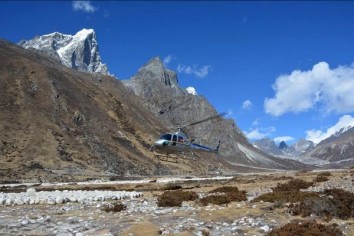
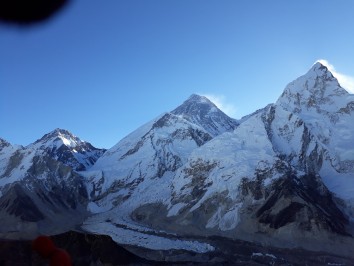
Trekking in Nepal 15 Days
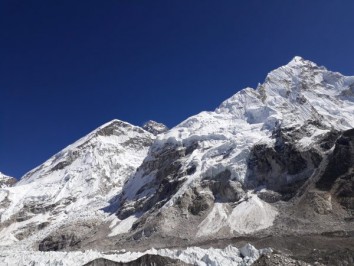
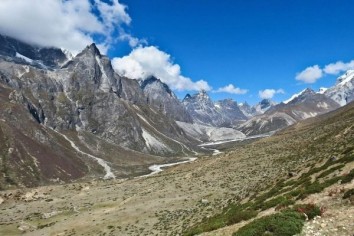
Trekking in Nepal 22 Days
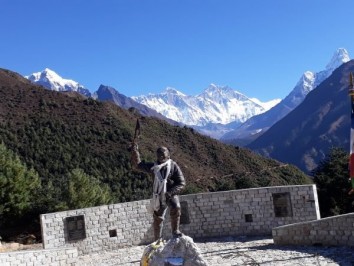
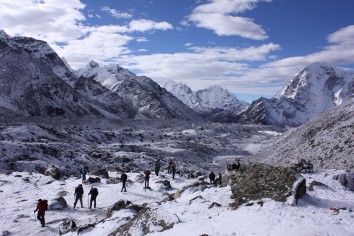
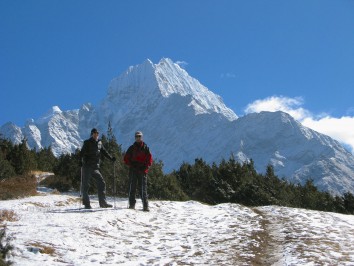
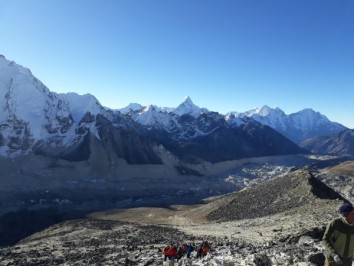
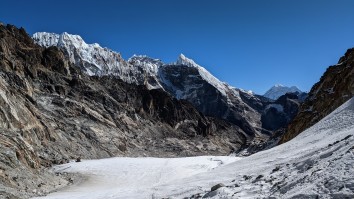
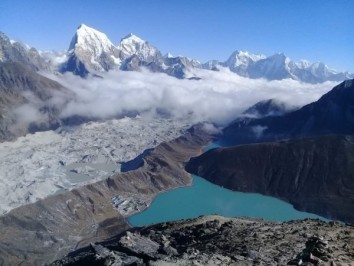
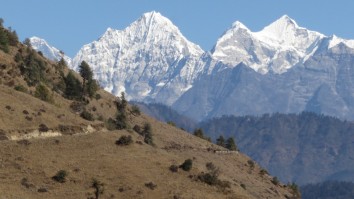

Trekking in Nepal 17 Days
Get the latest news, offers and inspiring travel stories straight to your inbox.
© 2011 - 2024 All rights reserved. Team Himalaya Pvt Ltd. Developed By: Xenatech Nepal.
Get the latest news, offers and inspiring travel stories straight to your inbox.
© 2011 - 2024 All rights reserved. Team Himalaya Pvt Ltd. Developed By: Xenatech Nepal.